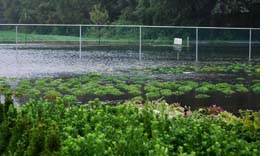Irene Hits Farms
- By Pia Hinckle
- Reading Time: 3 mins.
By Pia Hinckle
While damage varied from state to state and even within the same county, Tropical Storm Irene hit many farms from North Carolina to Vermont hard. Growers reported everything from flooded fields and broken trees to collapsed sheds and damaged fruit. Unrepaired roads, washed-out bridges and power outages still occurring in some areas made it difficult to fully assess the damage.
Thankfully, several farms that The FruitGuys works with reported little to mild damage:
 Three Springs Farm
Three Springs Farm
Three Springs Farm in Wenksville (North Adams County) PA posted a video showing a row of their Honey Crisp Apple trees that were blown over in the storm. Three Springs grows apples, peaches, cherries, apricots, pears, and vegetables on some 340 acres and is run by the seventh generation of the Wenk family. They told us: “Lots of damage on the farm, [but] only portions of it are really bad. In true Murphy’s Law fashion, the block sustaining the worst damage of any was our largest Honeycrisp block. Our market supply won’t be affected by this damage – great for most of you reading this, but we have wholesalers and packers who look forward to buying this fruit from us every year and those orders will be short. We also picked a barn full of ‘Honeycrisp’ before the storm.”
Landisdale Farm
Landisdale Farm is a family-run and certified organic farm in Lebanon County, PA. Here’s what they told us: “The seasons are changing on the farm. Talk about change! That was strange having a tremor shake us and a hurricane blow us! No extreme damage was done here. One roof has some tin coming off and the lettuces weren’t so thrilled about withstanding that wind!”
The Pennsylvania Farm Bureau reported that some farmers who had not yet harvested their apples when the storm hit lost between 20 to 50% of their crop. “The largest and most mature fruit fell off the trees,” Brad Hollabaugh of Hollabaugh Brothers Fruit Farm and Market in Biglerville, Adams County, said in a bureau press release. “There is nothing more disheartening than looking at apples on the ground after you’ve put your heart and soul into growing and nurturing the fruit throughout the season.”
Want farm-fresh fruit?
We've got you covered.
 Gasko’s Family Farm & Greenhouses, a nursery in Monroe Township, New Jersey, posted before and after photos showing extensively flooded fields.
Gasko’s Family Farm & Greenhouses, a nursery in Monroe Township, New Jersey, posted before and after photos showing extensively flooded fields.
Many upstate New York farms were underwater, according to the New York Daily News. With many late-summer crops still unharvested, such as corn, carrots, spinach, and squash, the storm couldn’t have come at a worse time. New York senators are requesting federal aid for the worst-hit farms. NY Governor Andrew Cuomo estimates at least $45 million in crop damages and 140,000 acres of farmland lost.
In Vermont, a time-lapse photography video shows floodwaters coming in to cover the fields at Diggers’ Mirth Collective Farm in Burlington. A portion shows farmers and volunteers moving through the fields to harvest what can be harvested before the flood.
NASA’s Earth Observatory posted a page showing the rainfall from Irene along the East Coast, ranging from 1.5 inches to more than 9 inches. Though Irene was downgraded from a hurricane to a tropical storm before making landfall, extended rainfall proved too much for many areas with soil already saturated by rain from summer storms. Tropical Storm Lee made landfall in Louisiana Sept. 4 and was bringing another bout of heavy rain along the East Coast. Meanwhile, the National Hurricane Center reported that Hurricane Katia, a category 2, was on its way north from Bermuda.


